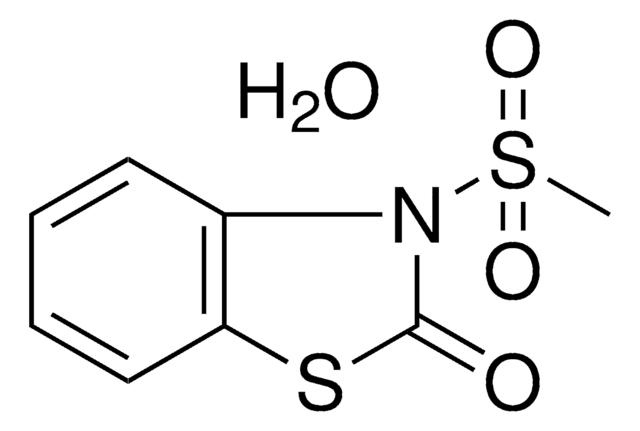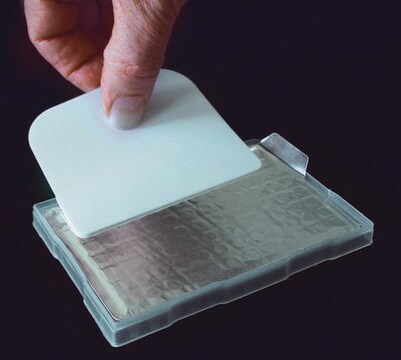Recommended Products
Quality Level
General description
The most commonly used method for assessing whether proteins are modified to contain cysteine sulfenic acid employs derivitization with 5,5-dimethyl-1,3-cyclohexanedione (dimedone), and subsequent detection with an antibody against dimedone-modified proteins. However, new reagents have been developed to simplify the analysis and isolation of proteins bearing cysteine sulfenic acid. DCP-Bio1, which consists of the sulfenic acid-reactive 3-(2,4-dioxocyclohexyl) propyl (DCP) appended to biotin, is a useful reagent for characterizing cellular cysteine sulfenic acid.
Application
Solutions:
DCP-Bio1 stock solution
Resuspend entire contents of vial in 10 µL DMSO for a final concentration of 250 mM
Stock lysis buffer
50 mM Tris-HCl, pH 7.5
100 mM Sodium Chloride
0.1% SDS
0.5% Sodium Deoxycholate
0.5% NP-40
0.5% Triton X-100
Working lysis buffer
On the day of the assay, supplement stock lysis buffer with:
50 mM Sodium Fluoride
1 mM PMSF
1 mM DCP-Bio1
100 µM DTPA (Diethylene triamine pentaacetic acid)
10 mM N-ethylmaleimide
10 mM iodoacetamide
200 U/mL catalase
1x protease inhibitor cocktail
Cell treatment and lysis:
1)Seed adherent cells in 100 mm cell culture dishes, or other plate as desired.
2)Change to fresh growth media 30 minutes before selected treatments.
3)Wash all plates 2 times with 10 mL 1x PBS.
4)Add 150 µL working lysis buffer to plates and scrape cells.
5)Incubate lysates on ice for 1-2 hours.
6)Centrifuge lysates at 10,000 rpm for 10 minutes and collect supernatant.
7)Remove un-reacted DCP-Bio1 and other small molecules using Bio-Rad P6-Spin Columns (PN: 732-6227) following manufacturer′s instructions.
8)Measure protein concentration.
9)Perform biochemical analysis of interest.
DCP-Bio1 stock solution
Resuspend entire contents of vial in 10 µL DMSO for a final concentration of 250 mM
Stock lysis buffer
50 mM Tris-HCl, pH 7.5
100 mM Sodium Chloride
0.1% SDS
0.5% Sodium Deoxycholate
0.5% NP-40
0.5% Triton X-100
Working lysis buffer
On the day of the assay, supplement stock lysis buffer with:
50 mM Sodium Fluoride
1 mM PMSF
1 mM DCP-Bio1
100 µM DTPA (Diethylene triamine pentaacetic acid)
10 mM N-ethylmaleimide
10 mM iodoacetamide
200 U/mL catalase
1x protease inhibitor cocktail
Cell treatment and lysis:
1)Seed adherent cells in 100 mm cell culture dishes, or other plate as desired.
2)Change to fresh growth media 30 minutes before selected treatments.
3)Wash all plates 2 times with 10 mL 1x PBS.
4)Add 150 µL working lysis buffer to plates and scrape cells.
5)Incubate lysates on ice for 1-2 hours.
6)Centrifuge lysates at 10,000 rpm for 10 minutes and collect supernatant.
7)Remove un-reacted DCP-Bio1 and other small molecules using Bio-Rad P6-Spin Columns (PN: 732-6227) following manufacturer′s instructions.
8)Measure protein concentration.
9)Perform biochemical analysis of interest.
Components
Quality
Storage and Stability
Disclaimer
Storage Class Code
11 - Combustible Solids
WGK
WGK 3
Flash Point(F)
Not applicable
Flash Point(C)
Not applicable
Regulatory Listings
Regulatory Listings are mainly provided for chemical products. Only limited information can be provided here for non-chemical products. No entry means none of the components are listed. It is the user’s obligation to ensure the safe and legal use of the product.
JAN Code
NS1226-5MG:
NS1226-1MG:
Certificates of Analysis (COA)
Search for Certificates of Analysis (COA) by entering the products Lot/Batch Number. Lot and Batch Numbers can be found on a product’s label following the words ‘Lot’ or ‘Batch’.
Already Own This Product?
Find documentation for the products that you have recently purchased in the Document Library.
Our team of scientists has experience in all areas of research including Life Science, Material Science, Chemical Synthesis, Chromatography, Analytical and many others.
Contact Technical Service





